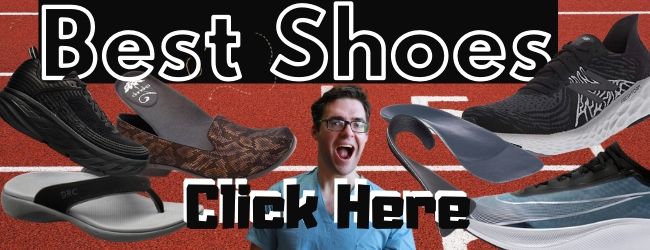Big Toe Joint, Hammer Toe & Bunionette Problems:
What Is A Bunion? [Causes, Symptoms & Best Treatment]
What is a bunion? It is the #1 cause of big toe joint pain and eventually arthritis! We go over the signs, symptoms and best treatment!
Look:
- Big toe joint pain can be improved with a few simple treatment changes.
- We are foot doctors & we see this problem get better almost every day.
- The goal is to solve this problem without medication or surgery if possible.
So, let’s GO!
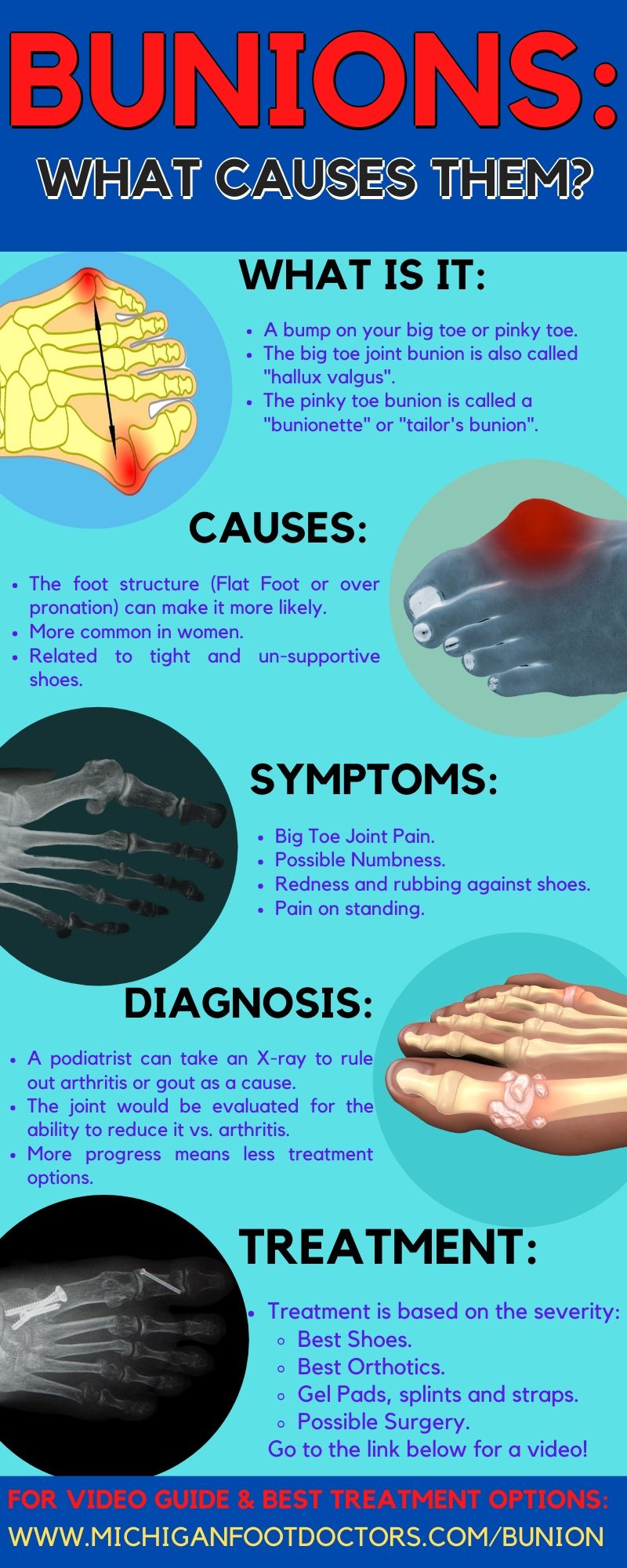
Table of Contents
Bunion Pictures & Photo Gallery:
Look:
- The associated photos are pictures of bunions.
- A big toe joint bunion is a prominence of the first metatarsal phalangeal joint.
- A tailor’s bunion is the prominence of the fifth metatarsal phalangeal joint.
- There are multiple stages of bunions ranging from minimal dislocation to severe dislocation to severe dislocation with arthritis.
- It is important to note that the sesamoid bones dislocate from the big toe joint and that the bunion itself is more of a dislocation injury than an arthritic injury.
- Although we frequently see bunions that also have arthritis, and is much more likely.
- We do perform minimally invasive bunion surgery at our clinic to limit the length of recovery time needed.
Please click on the gallery to read the description! Feel free to share pictures.
Causes of Big Toe Joint Pain:
- A bunion is the beginning of the dislocation of the big toe joint.
- The official term is subluxation, this is when the first metatarsal phalangeal joint starts to come out of the joint.
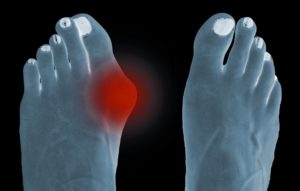
- This usually means the big toe joint is starting to point towards the second toe, this forces the second toe to rise over the big toe if it gets bad enough.
- This can contribute to forming a second toe hammer toe, as well as making the second, third, fourth, and fifth toes spread towards the outside of the foot.
- You can also develop a bunion to your fifth toe, this is called a tailor’s bunion, or a tailor’s bunionette.
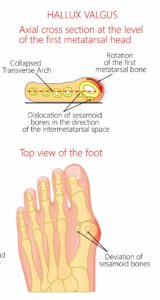
- A turf toe injury is the hyperextension of the first metatarsal phalangeal joint, also known as a big toe joint sprain.
- There are many tendons and ligaments and bones on the bottom of your big toe joint.
- If you strain the tendons and ligaments, these can take many weeks or many months to heal.
- If you ever watch professional football, or soccer, this is a very common sports injury when the big toe plants into the ground and all your body weight transfers over.
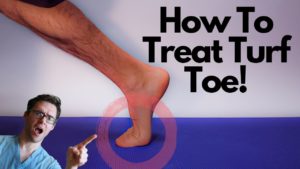
- There are two bones underneath your big toe joint called your sesamoids bones. These are the tibial sesamoid and the fibular sesamoid.
- If the big toe joint becomes disrupted, such as in a bunion these can become dislocated sesamoids.
- In sports such as basketball where there is a lot of pressure put on the big toe joint, this can lead to inflammation of the sesamoid bones. This is called the sesamoiditis.
- If your sesamoiditis gets really bad, it is also possible to get a broken sesamoid, or sesamoid fracture.
- It can be a good idea to see a podiatrist if you do have a broken or fractured sesamoid bone.
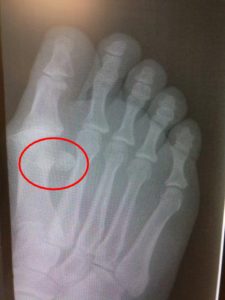
Big Toe Joint Arthritis (AKA Hallux Rigidus):
- Arthritis means that the cartilage is missing from your joint, this then prevents normal joint motion. Eventually as the damage keeps getting worse, the bone starts to crack, cause severe pain and eventually develop bone spurs and uneven bone at the site.
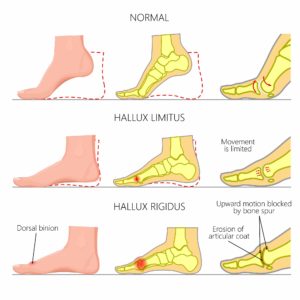
- In your big toe joint when you start to lose some motion, this is called hallux limitus. Eventually this starts to lose complete motion and this is now called hallux rigidus. This means that your big toe joint is rigid and unable to move.
- There are four stages to hallux rigidus,progressing from no arthritis to complete fused arthritis.
- Hallux rigidus and big toe joint arthritis essentially mean the same thing.
- This is a very common problem that we see especially in people who are on their feet all day, or have broken their toe in the past.
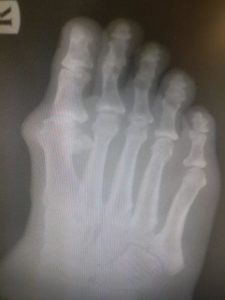
- Flat feet can be caused by many different things, and flat feet result in many different problems.
- The more your foot flattens, the more abnormal pressure is put onto your big toe joint. This can lead to abnormal pressure causing a dislocation also known as a bunion, or jamming of the cartilage which can lead to big toe joint arthritis or hallux rigidus.
- Flat fee are very complicated topic, as you can have a bunion in a high arched foot as well, but generally it is the act of over pronation that causes your big toe joint to receive pressure and become agitated.
- Controlling flat fee with more support has more pros than cons for sure.
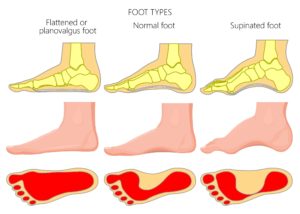
What is a bunion?
A bunion is a painful swelling of the soft tissue, and bone enlargement over the inside of the ball of the big toe. Often the big toe will look as if it is bent in towards the other toes or even can lie across them.
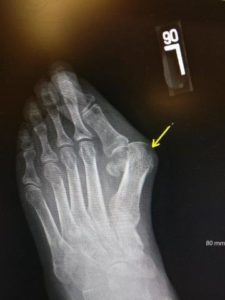
Bunion Symptoms:
- A bunion usually results in irritated skin around the bunion, pain when walking, joint redness and pain, and possible shift of the big toe toward the other toes. Corns, calluses and blisters are also very likely to form over time to create addition pain.
- It is also very common for a bunion to eventually lead to the formation of a hammertoe to the second and eventually the third toe as well.
- As the bunion and the other toes further deform, this can lead to difficulties finding properly fitted footwear and may force a person to buy a larger size shoe to accommodate the width the bunion creates.
- If the bunion deformity becomes severe enough, the foot can hurt in different places even without the constriction of shoes.
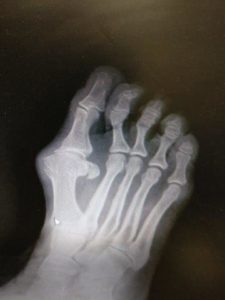
Symptoms Include:
- Pain in and around the ball of the big toe. This can be from the bone rubbing too much on the shoes.
- You may be unable to wear certain types of shoes.
- The big toe appears to be bent inwards.
- This is more due to the 1st metatarsal migrating outwards as shown in the image opposite.
- Other causes of 1st MTPJ joint pain can include turf toe and gout.
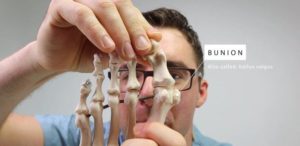
What Causes Bunions?
- Biomechanical factors can contributeto the development of bunions for example if you pronate excessively.
- Wearing high heeled shoes regularly increases the risk of developing bunions.
- Age increases the likelihood of developing bunions as the ligaments loose strength with age.
- Although some experts are convinced that poor-fitting footwear is the main cause of bunion formation, some studies do show that footwear only exacerbates the problem caused by the original genetic structure.
- Some people are much more likely to develop bunions than other people based on what their parents feet looked like!
Best Bunion Relief Infographic:
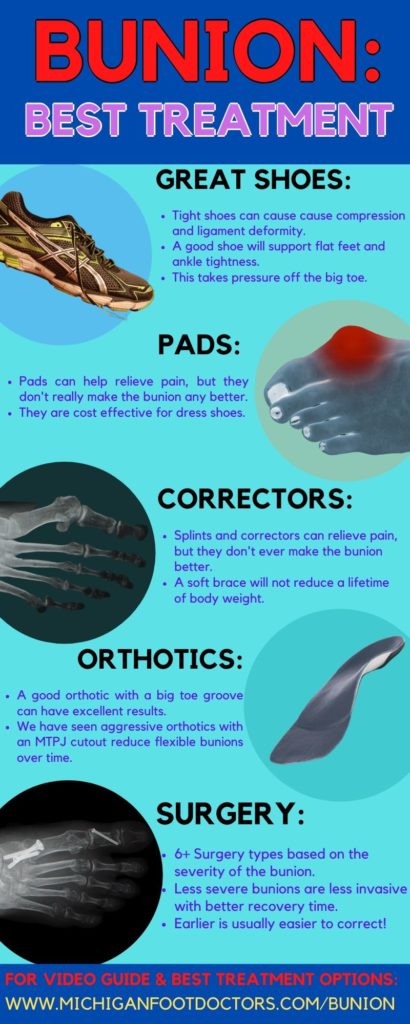
Bunion Home Treatment:
Can you reverse a bunion without surgery?
- Separate the big toe and the next one with a 1 cm thick piece of foam, or try a bunion splint
- Shield the bunions by cutting a hole for it in a piece of padding.
- See a sports injury specialist or podiatrist and have orthotic devices made.
What can a specialist do?
- They can make orthotic devices for your feet and in bad cases can refer you for an operation on the bunions.
- Bunion surgery to realign the joint is a last resort.
Bunion Orthotic Treatment:
- In our experience, approximately 50-75% of people with bunions feel good enough with orthotics and bracing that they never do require surgery.
- The only downside of this is that the bunion is not fixed structurally.
- This does prevent the bunion from getting worse going into the future.
Scientific Evidence of Orthotics:
- Orthotics are now very proven devices.
- There are hundreds of high level studies showing the clear effect of these outcomes.
- Orthotics are now condition specific and not just cookie cutter molds that you can buy at the store.
- There are many different modifications and adjustments throughout the process that need to be made.
- The most important part is making sure they fit and function for you.
- Think of orthotics as optical glasses, they need extensive evaluation to make the first place for sure. But once they are made you will not be able to go back to the pain you have had in the past.
Bunion Surgery:
Bunion surgery can be needed in some cases.
Watch our Bunion Surgery Video Guide!
There are numerous types of bunion surgeries, these include:
- Chevron bunionectomy.
- The first tarsal metatarsal joint bunionectomy. This can be also known as a Lapidus or let the plastic.
- The first metatarsal joint effusion.
- A distal metatarsal osteotomy.
- A proximal metatarsal osteotomy.
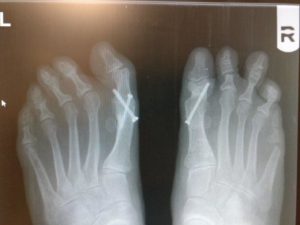
Bunion Home Treatment:
- If you have read the above causes and symptoms, and you are confident that that what you have is a bunion, then the below might be a good idea to look through.
Instant Pain Relief:
- The key to instant pain relief is icing. For best results ice 20 minutes at a time.
- Studies also show that bio freeze or other mental based creams can be very effective.
- Studies do show that bio freeze can last two times as long as vice. This will give you excellent relief, especially when you’re going to bed in your foot is throbbing.








Keys to a permanent cure:
- Accept that you have an injury, even if you’re doing everything right, this inflammation and soreness take 1, 2 or even 3 months to get completely better again.
- There is no magic solution like a cream that can make it go away permanently and immediately.
Get a good supportive running shoe:
- The first step is to get a good supportive running shoe, if you have any questions with this comes your podiatrist or get something that you would feel comfortable running a marathon in.
- Take a look at what people are running marathons and, it’s not a decked out signature Nike or Under Armor shoe!
- The first thing you need to do is look at your shoes: most patients that we see think they are wearing great shoes, but they can actually be terrible shoes.
- In today’s world of marketing, commercials make it seem like a shoe is great for you, it can actually be a terrible shoe! We see hard-working and well-intentioned athletes come in with terrible unsupported and flimsy shoes. This is even the case if you buy $200 plus shoes!
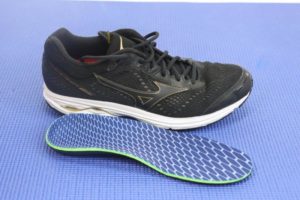
The Best Orthotics:
- This is very cheap investment to get rid of your foot pain.
- There are much cheaper over-the-counter custom options available as well.
- Do your best to avoid the flimsy gel pads.
- These are our recommended orthotics:
Full-length orthotics are the best orthotic for healing your bunion and ball of the foot instability.
The downside is that they do take up much more room in your shoe.








If you have a dry shoe, consider a recommended dress shoe orthotics:






If you have acute shoe or a woman’s shoe, consider these minimalist orthotics.


Injections:
- This is not something that we would recommend doing at home, but a doctor can help you with this.
- If you do have severe pain that is really preventing you from doing anything, this may be an option in the right circumstances.
Medications:
- Anti-inflammatory medications could be good, but we do not recommend this as a long-term solution.
- Focus on the orthotics in the shoes.
When is surgery a good option? Probably only 10% of the time!
- If you have tried all the above stuff, and a couple months have gone by and you have not started to improve at all, then further and imaging like an ultrasound, x-ray or MRI might make sense.
- If you have long-term permanent damage to the nerve, especially if it has been going on for over 6 to 12 months, then you may need surgery.
- Bunion surgery has its benefits, but any type of surgery may have its negatives.
- Make sure to check with a podiatrist to see if you qualify. You may be one of the 10% for whom it may be a great idea!
For more on Can Bunions be Reversed without Surgery?
And Remember… Get Great Shoes!
Big Toe Joint, Hammer Toe & Bunionette Problems:
